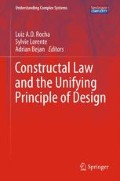Abstract
Heat transfer within the human skin is a complicated process involving metabolic heat generation, heat conduction and blood perfusion in tissue, convection and perfusion of the arterial-venous blood through the capillary, and interaction with the environment. Modeling of heat-related phenomena such as bioheat transfer is important in the development of biological and biomedical technologies, such as thermotherapy of skin cancer and the design of heating or cooling garments, as well as protecting human life in cases of accidental or natural disasters [1, 2]. In this chapter, the constructal theory of multi-scale tree-shaped heat exchangers is applied to the vascular countercurrent network embedded in a three-dimensional triple layered skin structure. Based on the designed vascular countercurrent network, we present our mathematical models and numerical results for predicting skin burn injury induced by intense radiation heating and for optimizing skin temperature induced by laser or electromagnetic radiations related to hyperthermia cancer treatments.
Access this chapter
Tax calculation will be finalised at checkout
Purchases are for personal use only
References
Borkebak RC. Heat transfer in biological systems. Int Rev Gen Exper Zool. 1966;2:269–344.
Bowman HF, Cravalho EG, Woods M. Theory, measurement and application of properties of biomaterials. Annu Rev Biophys Bioeng. 1975;4:43–80.
Bergman TL, Faghri A, Viskanta R. Frontiers in transport phenomena research and education: energy systems, biological systems, security, information technology and nanotechnology. Int J Heat Mass Tran. 2008;53:4599–613.
Lubashevsky IV, Gafiychuk V. Mathematical description of heat transfer in living tissue. Unpublished book
Chato JC. Fundamentals of bioheat transfer. In: Gautherie M, editor. Clinical thermology: thermal dosimetry and treatment planning. Berlin: Springer; 1990.
Gartner LP. Color atlas of histology. 3rd ed. Philadelphia: Lippincott Williams and Wilkins; 2000.
Bejan A. Shape and structure, from engineering to nature. Cambridge: Cambridge University Press; 2000.
Bejan A. The tree of convective heat streams: its thermal insulation function and the predicted 3/4-power relation between body heat loss and body size. Int J Heat Mass Tran. 2001;44:699–704.
Bejan A, Lorente S. Constructal theory of generation of configuration in nature and engineering. J Appl Phys. 2006;100:041301.
Bejan A, Lorente S. Design with constructal theory. Hoboken: Wiley; 2008.
da Silva AK, Lorente S, Bejan A. Constructal multi-scale tree-shaped heat exchangers. J Appl Phys. 2004;96:1709–18.
Dai W, Bejan A, Tang X, Zhang L, Nassar R. Optimal temperature distribution in a 3D triple layered skin structure with embedded vasculature. J Appl Phys. 2006;99:104702.
Dai W, Wang H, Jordan PM, Mickens RE, Bejan A. A mathematical model for skin burn injury induced by radiation heating. Int J Heat Mass Tran. 2008;51:5497–510.
Tang X, Dai W, Nassar R, Bejan A. Optimal temperature distribution in a 3D triple layered skin structure embedded with artery and vein vasculature. Numer Heat Transfer A. 2006;50:809–43.
Wang H, Dai W, Bejan A. Optimal temperature distribution in a 3D triple layered skin structure embedded with artery and vein vasculature and induced by electromagnetic radiation. Int J Heat Mass Tran. 2007;50:1843–54.
Zeng X, Dai W, Bejan A. Vascular countercurrent network for 3D triple-layered skin structure with radiation heating. Numer Heat Transfer A. 2010;57:369–91.
Huang H, Chen ZP, Roemer R. A counter current vascular network model of heat transfer in tissues. J Biomech Eng. 1996;118:120–9.
Majchrzak E, Mochnacki B. Numerical model of heat transfer between blood vessel and biological tissue. Comput Assist Mech Eng Sci. 1999;6:439–47.
Liu J. Preliminary survey on the mechanisms of the wave-like behaviors of heat transfer in living tissues. Forschung im Ingenieurwesen. 2000;66:1–10.
Liu J, Chen X, Xu LX. New thermal wave aspects on burn evaluation of skin subjected to instantaneous heating. IEEE Trans Biomed Eng. 1999;46:420–8.
Tzou DY. Macro-to-microscale heat transfer: the lagging behavior. Washington: Taylor and Francis; 1996.
Mitra K, Kumar S, Vedavarz A, Moallemi MK. Experimental evidence of hyperbolic heat conduction in processed meat. Trans ASME J Heat Transfer. 1995;117:568–73.
Sturesson C, Andersson-Engels A. A mathematical model for predicting the temperature distribution in laser-induced hyperthermia: experimental evaluation and applications. Phys Med Biol. 1995;40:2037–52.
Henriques FC, Mortiz AR. Studies of thermal injury in the conduction of heat to and through skin and the temperature attained therein: a theoretical and experimental investigation. Am J Pathol. 1947;23:531–49.
Diller KR. Modeling of bioheat transfer processes at high and low temperature. In: Cho YI, Hartnett JP, Irvine Jr TF, editors. Advanced in heat transfer, 22. New York: Academic; 1992. p. 157–357.
Jaesung H, Klavs FJ. Combined experimental and modeling studies of laser-assisted chemical vapor deposition of copper from copper (I)-hexafluoroacetylacetonate-trimethylviny-lsilane. J Appl Phys. 1994;75:2240–50.
Cole KS, Cole RH. Dispersion and absorption in dielectrics I. alternating current characteristics. J Chem Phys. 1941;9:341–51.
Gabriel S, Lau RW, Gabriel C. The dielectric properties of biological tissues: III. parametric models for the dielectric spectrum of tissues. Phys Med Biol. 1996;41:2271–93.
Dincov DD, Parrott KA, Pericleous KA. A new computational approach to microwave heating of two-phase porous materials. Int J Numer Method Heat & Fluid Flow. 2004;14:783–802.
Sullivan DM. Electromagnetic simulation using the FDTD method. New York: IEEE; 1999.
Author information
Authors and Affiliations
Corresponding author
Editor information
Editors and Affiliations
Rights and permissions
Copyright information
© 2013 Springer Science+Business Media New York
About this chapter
Cite this chapter
Dai, W. (2013). Constructal Theory Applied to Vascular Countercurrent Networks. In: Rocha, L., Lorente, S., Bejan, A. (eds) Constructal Law and the Unifying Principle of Design. Understanding Complex Systems. Springer, New York, NY. https://doi.org/10.1007/978-1-4614-5049-8_9
Download citation
DOI: https://doi.org/10.1007/978-1-4614-5049-8_9
Published:
Publisher Name: Springer, New York, NY
Print ISBN: 978-1-4614-5048-1
Online ISBN: 978-1-4614-5049-8
eBook Packages: Physics and AstronomyPhysics and Astronomy (R0)

